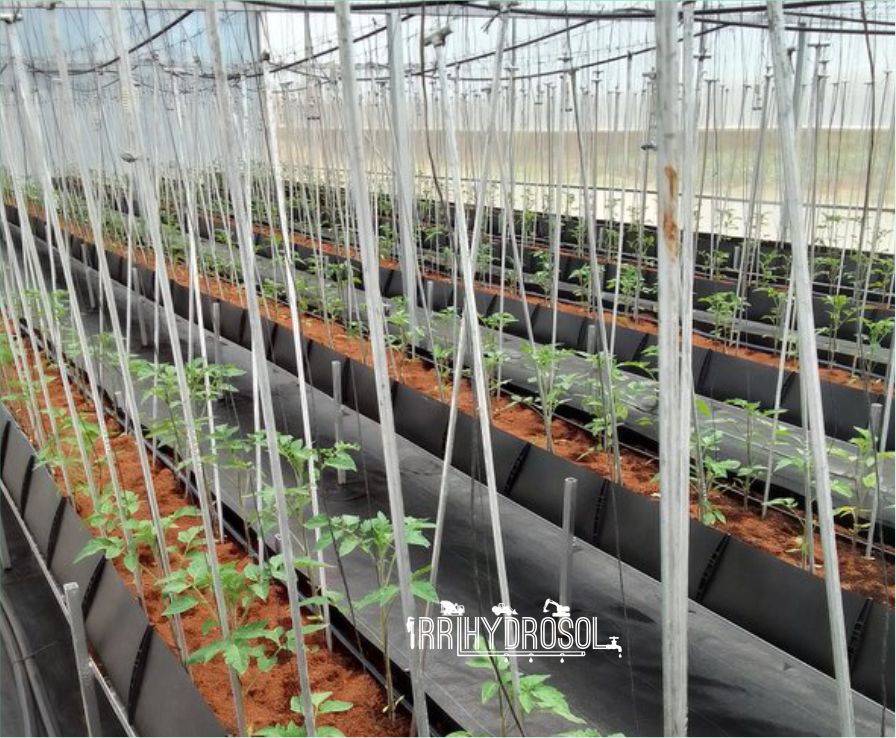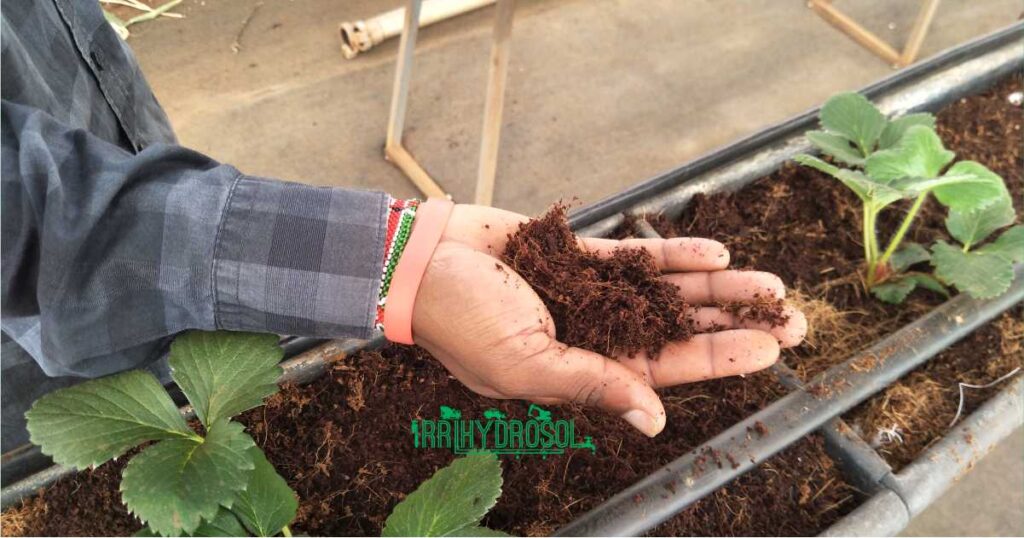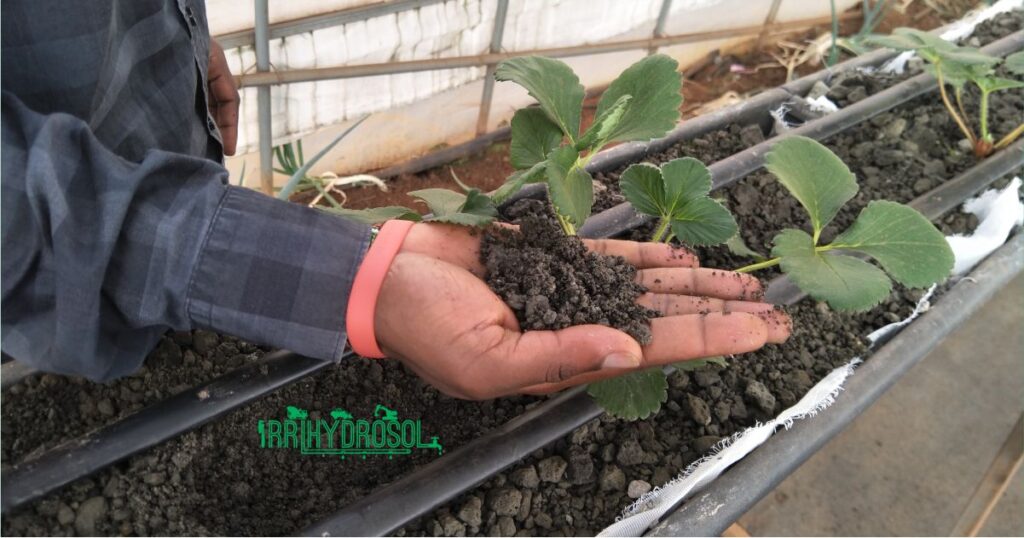Hydroponics is a soilless method of growing crops, where an inert material is used in the place of soil, and the root zone is supplied with a nutrient-rich solution. This farming method is fit for urban areas where there is minimal farming land, or where diseases and soil contaminants have made it impossible to farm. Farmers are thus able to farm indoors (greenhouse/net houses) or in their backyards and balconies. Additionally, farmers are also able to save on fungicides and insecticides, which are associated with the normal farming methods. At Irrihydrosol Ltd., we offer training, design, and supply hydroponic systems that are tailored to the farmer’s needs.
Why Choose Hydroponic Farming in Kenya?

i) Farming Anywhere
Hydroponics allows cultivation in diverse environments, from Arid and Semi-Arid Lands (ASALS) to urban settings, overcoming traditional farming challenges.
ii) Increased Yields
Hydroponic plants experience rapid growth and maturity, leading to higher yields than soil-based farming.
iii) Water Conservation
Hydroponic systems utilize up to 90% less water by recycling and minimizing evaporation.
iv) Reduced Inputs
Hydroponics requires less daily maintenance and labor than traditional farming, saving time and effort.
v) Enhanced Productivity
Vertical and horizontal hydroponic systems optimize space utilization, increasing crop production per unit area.
Types of Hydroponic Systems We Offer
Hydroponic systems vary greatly in design based on their intended use. Below is an overview of several of these systems:
1. Food Crop Production Systems
As the name implies, these systems are used for growing:
- Leafy vegetables: Lettuce, Sukuma wiki, and spinach.
- Herbs: mint, basil, dhania and rosemary.
- Fruits: Tomatoes, strawberries, and bell peppers.
This farming methods bears more yields when compared to traditional methods as the plants are fed a balanced diet, have less risk of diseases, and have adequate supply of water.
2. Aquaponics Systems - The Perfect Symbiosis
This is the hybrid combination of aquaculture (fish farming) and hydroponics (soilless farming). The system uses the nutrient rich water from the fish excrement, where the plants purify the water before it is circulated back to the fish pond.
Step 1: The water from the fish pond contains waste which is ammonia.
Step 2: Nitrosomonas bacteria break down ammonia into nitrites.
Step 3: Nitrobacter bacteria convert the nitrites into nitrates, which can be absorbed by plants.
Step 4: The plants absorb the nitrates and other micro-nutrients.
Step 5: The water is filtered and circulated back to the fish pond.
3. Hydroponic Fodder Production Systems
These systems are transforming the livestock farming sector as farmers are able to produce animal feed in a few days. The method is water and space efficient, and the amount of produce per square area is unmatched. The crops used in producing the fodder include maize, sorghum and barley. In hydroponics, these crops are typically grown for only 6-8 days, consuming only 3-4 liters of water, and are ready to be fed to the animals. These systems are being used for cattle, sheep, rabbit, and pig rearing, among other animals.
Essential Components of Professional Hydroponic Systems


1. Premium Growing Media
This is the material that anchors the root zone of the plant and does not retain water nor compact the roots. Its main function is to just hold the roots in place for water, nutrients and air uptake. These inert materials include:
- Cocoa peat
- Pumice
- Rockwool
- Perlite
2. Precision Nutrient Solutions
An aqueous solution of plant nutrients is supplied to the plant root zone through pumping or gravity. These nutrients include magnesium, calcium, and phosphorus.
3. Optimal Lighting Solutions
Whether the hydroponic system is in a greenhouse or in the backyard, the farmer must ensure that the plants have enough access to sun light. For healthy growth, the plant must reach its Daily Light Integral (DLI) in order to photosynthesize enough food.
4. Water Quality Management
The farmer should also ensure that the water used is clean of the correct pH levels, specific to the plant.
5. Complete Infrastructure Solutions
i) Growing Structures
The structures are dependent on the available farming space, the crops to be grown, and the client’s specification. These structures may include, a greenhouse or net house, and supporting platforms for vertical farming and to hold hydroponic trays and troughs.
ii) Water Circulation Systems
Hydroponic systems require a system that circulates the nutrient-rich water all around. This may include storage tanks, a piping system, and a pump.
iii) Filtration and Monitoring
Filtering the water is vital for a hydroponic system, especially those that encompass a drip system, therefore minimizing blockages.
iv) Growing Platform
Plant growing platforms are quite broad in hydroponics. They may be vertical perforated pipes for vertical farms, HDPE lined, troughs, treys or even containers. Their main purpose is to hold the plant into place to grow, while the root zone gets supplied with the nutrient rich water.
Frequently Asked Questions About Hydroponic Farming
What is hydroponic farming?
Hydroponics is a soilless method of growing crops, where an inert material is used in the place of soil, and the root zone is supplied with a nutrient-rich solution.
Why is hydroponic farming suitable for Kenya?
Hydroponic farming allows farmers to grow crops in areas that would otherwise not be productive; areas with poor soils, minimal space, and unfavorable weather. Plants can be grown in balconies and backyards.
Can I grow different crops using hydroponics?
Yes! Hydroponics supports a wide range of crops which include vegetables, fruits, herbs and fodder.
How does hydroponics save water?
In hydroponics, water is filtered and recirculated back to the system. Reusing the water reduces wastage, therefore using up to 90% less water than traditional soil farming.
Do I need special fertilizers for hydroponics?
Yes! You’ll need fertilizers that are soluble in water, so as to be circulated to the plants root zone.
Is hydroponic farming expensive to start?
The initial setup may require some bit of investment, but it eventually pays off through higher yields, lower water usage, and reduced labor costs.
Is hydroponics good for small-scale farmers?
These systems can be scaled to fit any farm size; from farming in backyards and balconies to large commercial setups.
What infrastructure do I need?
- Growing structure: The structures are dependent on the available farming space, the crops to be grown, and the client’s specification. These structures may include, a greenhouse or net house, and supporting platforms for vertical farming and to hold hydroponic trays and troughs.
- Water circulation System: Hydroponic systems require a system that circulates the nutrient-rich water all around. This may include storage tanks, a piping system, and a pump.
- A Water filtration system: filtering the water is vital for a hydroponic system, especially those that encompass a drip system, therefore minimizing blockages.
- Growing Platform: Plant growing platforms are quite broad in hydroponics. They may be vertical perforated pipes for vertical farms, HDPE lined, troughs, treys or even containers. Their main purpose is to hold the plant into place to grow, while the root zone gets supplied with the nutrient rich water.
Where can I get hydroponics support or equipment?
At Irrihydrosol Ltd., we offer training, design, and supply hydroponic systems that are tailored to the farmer’s needs.
Borehole drilling and servicing
Irrigation products and services
For information contact us here
Connect with us on Facebook
